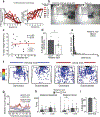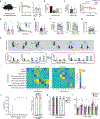Cortical ensembles orchestrate social competition through hypothalamic outputs
- PMID: 35296862
- PMCID: PMC9576144
- DOI: 10.1038/s41586-022-04507-5
Cortical ensembles orchestrate social competition through hypothalamic outputs
Abstract
Most social species self-organize into dominance hierarchies1,2, which decreases aggression and conserves energy3,4, but it is not clear how individuals know their social rank. We have only begun to learn how the brain represents social rank5-9 and guides behaviour on the basis of this representation. The medial prefrontal cortex (mPFC) is involved in social dominance in rodents7,8 and humans10,11. Yet, precisely how the mPFC encodes relative social rank and which circuits mediate this computation is not known. We developed a social competition assay in which mice compete for rewards, as well as a computer vision tool (AlphaTracker) to track multiple, unmarked animals. A hidden Markov model combined with generalized linear models was able to decode social competition behaviour from mPFC ensemble activity. Population dynamics in the mPFC predicted social rank and competitive success. Finally, we demonstrate that mPFC cells that project to the lateral hypothalamus promote dominance behaviour during reward competition. Thus, we reveal a cortico-hypothalamic circuit by which the mPFC exerts top-down modulation of social dominance.
© 2022. The Author(s), under exclusive licence to Springer Nature Limited.
Conflict of interest statement
Competing interest statement:
The authors declare no competing interests.
Figures














References
-
- Chiao JY Neural basis of social status hierarchy across species. Curr. Opin. Neurobiol. 20, 803–809 (2010). - PubMed
-
- Wang F, Kessels HW & Hu H The mouse that roared: neural mechanisms of social hierarchy. Trends Neurosci. 37, 674–682 (2014). - PubMed
-
- Bernstein IS Dominance: The baby and the bathwater. Behav. Brain Sci. 4, 419–457 (1981).
-
- Dewsbury DA Dominance Rank, Copulatory Behavior, and Differential Reproduction. Q. Rev. Biol. 57, 135–159 (1982). - PubMed

